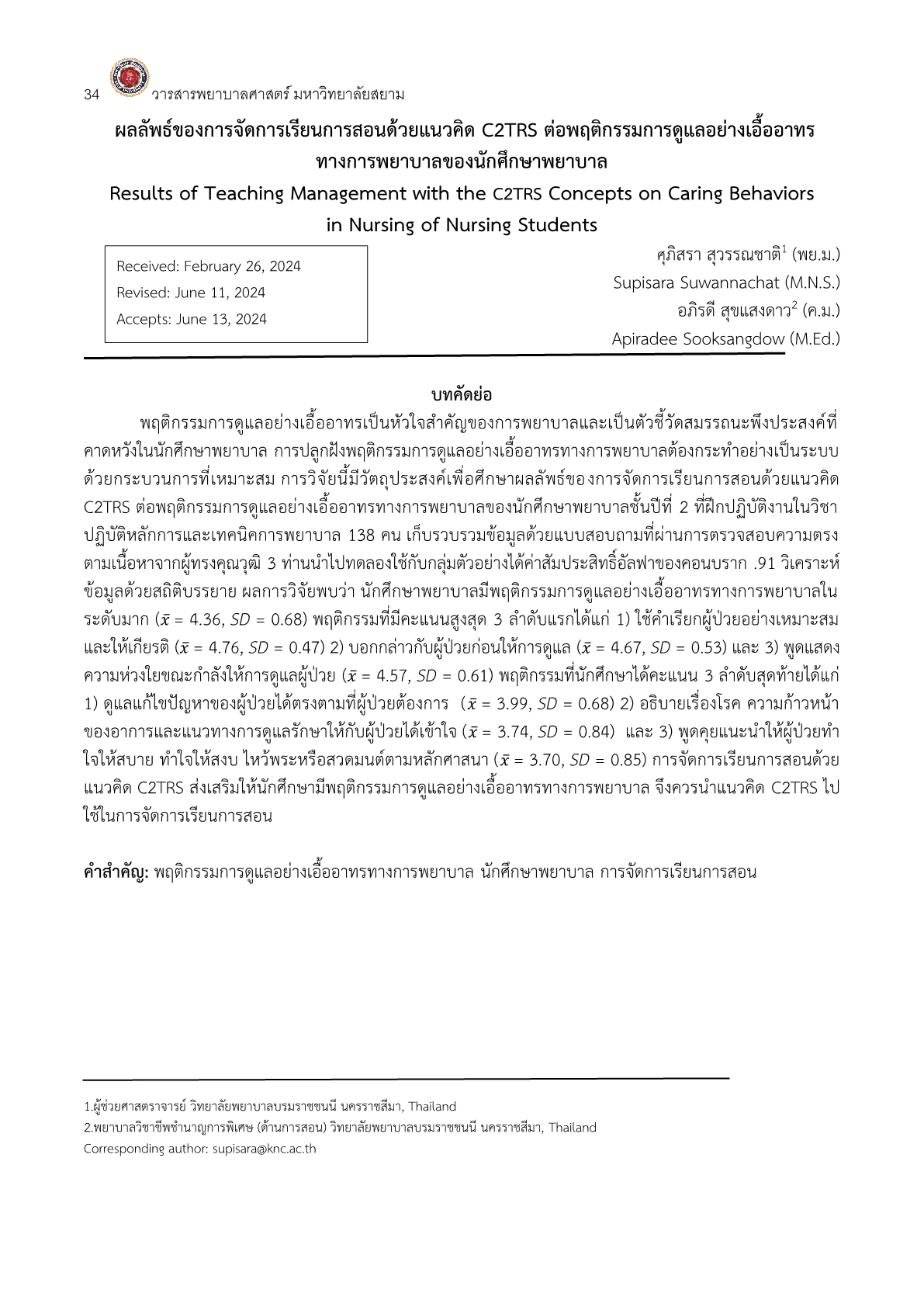ผลลัพธ์ของการจัดการเรียนการสอนด้วยแนวคิด C2TRS ต่อพฤติกรรมการดูแลอย่างเอื้ออาทรทางการพยาบาลของนักศึกษาพยาบาล
คำสำคัญ:
พฤติกรรมการดูแลอย่างเอื้ออาทรทางการพยาบาล, นักศึกษาพยาบาล, การจัดการเรียนการสอนบทคัดย่อ
พฤติกรรมการดูแลอย่างเอื้ออาทรเป็นหัวใจสำคัญของการพยาบาลและเป็นตัวชี้วัดสมรรถนะพึงประสงค์ที่คาดหวังในนักศึกษาพยาบาล การปลูกฝังพฤติกรรมการดูแลอย่างเอื้ออาทรทางการพยาบาลต้องกระทำอย่างเป็นระบบด้วยกระบวนการที่เหมาะสม การวิจัยนี้มีวัตถุประสงค์เพื่อศึกษาผลลัพธ์ของการจัดการเรียนการสอนด้วยแนวคิด C2TRS ต่อพฤติกรรมการดูแลอย่างเอื้ออาทรทางการพยาบาลของนักศึกษาพยาบาลชั้นปีที่ 2 ที่ฝึกปฏิบัติงานในวิชาปฏิบัติหลักการและเทคนิคการพยาบาล 138 คน เก็บรวบรวมข้อมูลด้วยแบบสอบถามที่ผ่านการตรวจสอบความตรงตามเนื้อหาจากผู้ทรงคุณวุฒิ 3 ท่านนำไปทดลองใช้กับกลุ่มตัวอย่างได้ค่าสัมประสิทธิ์อัลฟาของคอนบราก .91 วิเคราะห์ข้อมูลด้วยสถิติบรรยาย ผลการวิจัยพบว่า นักศึกษาพยาบาลมีพฤติกรรมการดูแลอย่างเอื้ออาทรทางการพยาบาลในระดับมาก ( = 4.36, SD = 0.68) พฤติกรรมที่มีคะแนนสูงสุด 3 ลำดับแรกได้แก่ 1) ใช้คำเรียกผู้ป่วยอย่างเหมาะสมและให้เกียรติ ( = 4.76, SD = 0.47) 2) บอกกล่าวกับผู้ป่วยก่อนให้การดูแล ( = 4.67, SD = 0.53) และ 3) พูดแสดงความห่วงใยขณะกำลังให้การดูแลผู้ป่วย ( = 4.57, SD = 0.61) พฤติกรรมที่นักศึกษาได้คะแนน 3 ลำดับสุดท้ายได้แก่ 1) ดูแลแก้ไขปัญหาของผู้ป่วยได้ตรงตามที่ผู้ป่วยต้องการ ( = 3.99, SD = 0.68) 2) อธิบายเรื่องโรค ความก้าวหน้าของอาการและแนวทางการดูแลรักษาให้กับผู้ป่วยได้เข้าใจ ( = 3.74, SD = 0.84) และ 3) พูดคุยแนะนำให้ผู้ป่วยทำใจให้สบาย ทำใจให้สงบ ไหว้พระหรือสวดมนต์ตามหลักศาสนา ( = 3.70, SD = 0.85) การจัดการเรียนการสอนด้วยแนวคิด C2TRS ส่งเสริมให้นักศึกษามีพฤติกรรมการดูแลอย่างเอื้ออาทรทางการพยาบาล จึงควรนำแนวคิด C2TRS ไปใช้ในการจัดการเรียนการสอน
เอกสารอ้างอิง
กนกรัตน์ วงษ์หีบทอง, กทลี กล่อมอู่, กนกวรรณ ด่านจิตติศิริ, กมลรัชต์ เที่ยงตรง, นิลวรรณ เที่ยงจันทร์, วราภรณ์ ทองดอนง้าว, อาภาภรณ์ เตมีย์เจริญถาวร, ยังเดน คินแซง, และวงเดือน สุวรรณคีรี. (2563). พฤติกรรมการดูแลอย่างเอื้ออาทรของนิสิตพยาบาล มหาวิทยาลัยนเรศวร. วารสารพยาบาล, 69(4), 11-20. สืบค้นจาก https://he02.tci-thaijo.org/index.php/TJN/article/view/242081/168730
จินดามาศ โกศลชื่นวิจิตร. (2556). การดูแลอย่างเอื้ออาทร : หัวใจสำคัญของการบริการด้วยหัวใจความเป็นมนุษย์. วารสารวิทยาลัยพยาบาลบรมราชชนนี กรุงเทพ, 29(2), 134-141. สืบค้นจาก https://he01.tci-thaijo.org/index.php/bcnbangkok/article/view/28978/24921
จอนผะจง เพ็งจาด. (2553). การใช้ทฤษฎีการดูแลมนุษย์ของวัตสันในการพยาบาลผู้ป่วยแบบประคับประคอง. วารสารพยาบาลสภากาชาดไทย, 3(1-3), 1-17. สืบค้นจาก https://he02.tci-thaijo.org/index.php/trcnj/article/view/40052/33053
ชุติมา สืบวงศ์ลี, ศิริเดช สุชีวะ, และสุวิมล ว่องวาณิช. (2554). การพัฒนาเครื่องมือประเมินพฤติกรรมการดูแลอย่างเอื้ออาทรทางการพยาบาลโดยใช้เทคนิคการสัมภาษณ์เชิงปัญญา. วารสารวิจัย, 7(2), 127-142. สืบค้นจาก https://so03.tci-thaijo.org/index.php/sduhs/article/view/5150/4509
ชุลีพร พรหมพาหกุล, วราภรณ์ คงสุวรรณ, และบุศรา หมื่นศิริ. (2565). ปัจจัยที่มีผลต่อพฤติกรรมการดูแลผู้ป่วยระยะท้ายแบบเอื้ออาทรของนักศึกษาพยาบาลชั้นปีที่ 4 มหาวิทยาลัยสงขลานครินทร์. วารสารวิจัยทางการพยาบาล การผดุงครรภ์และวิทยาศาสตร์สุขภาพ, 42(2), 1-10. สืบค้นจาก https://he02.tci-thaijo.org/index.php/nur-psu/article/view/255333/175578
ทัศนีย์ ทิพย์สูงเนิน, วัลภา สบายยิ่ง, นิรนาท แสนสา, และ จินดามาศ โกศลชื่นวิจิตร (2563) โมเดลเชิงสาเหตุของพฤติกรรมการดูแลอย่างเอื้ออาทรของนักศึกษาพยาบาลวิทยาลัยพยาบาลในสังกัดสถาบันพระบรมราชชนก. วารสารเครือข่ายวิทยาลัยพยาบาลและการสาธารณสุขภาคใต้, 7(1), 16-31. สืบค้นจาก https://he01.tci-thaijo.org/index.php/scnet/article/view/175934/160693
นรากูล พัดทอง. (2558). สัมพันธภาพเชิงช่วยเหลืออย่างเอื้ออาทรของอาจารย์นิเทศตามการรับรู้ของ นักศึกษาพยาบาล และพฤติกรรมการดูแลอย่างเอื้ออาทรของนักศึกษาพยาบาล ตามการรับรู้ของผู้รับบริการขณะฝึกปฏิบัติการพยาบาล. วารสารวิจัยทางวิทยาศาสตร์สุขภาพ, 9(2), 59-63. สืบค้นจาก https://he01.tci-thaijo.org/index.php/JHR/article/view/56678/47173
บุญชม ศรีสะอาด. (2560). การวิจัยเบื้องต้น (พิมพ์ครั้งที่ 10). กรุงเทพฯ: สุวีริยาสาส์น.
ปราณี มีหาญพงศ์ และกรรณิการ์ ฉัตรดอกไม้ไพร. (2561). การตรวจสอบคุณภาพของเครื่องมือวิจัยทางการพยาบาล. วารสารพยาบาลทหารบก, 19(1), 9-15. สืบค้นจาก https://he01.tci-thaijo.org/index.php/JRTAN/article/view/121885/92855
มยุรี ลิ่ทองอิน และสิริมาศ ปิยะวัฒนพงศ์. (2558). ปัจจัยร่วมทำนายพฤติกรรมการพยาบาลเอื้ออาทรผู้สูงอายุของนักศึกษาพยาบาลในวิชาปฏิบัติการพยาบาล. วารสารการพยาบาลและการดูแลสุขภาพ, 33(3), 70-79. สืบค้นจาก https://he01.tci-thaijo.org/index.php/jnat-ned/article/view/45992/38036
เยาวรัตน์ มัชฌิม และบวรลักษณ์ ทองทวี. (2562). พฤติกรรมการดูแลแบบเอื้ออาทรในการดูแลผู้ป่วยระยะสุดท้ายของนักศึกษาพยาบาลและพยาบาลจบใหม่และปัจจัยที่เกี่ยวข้อง. วารสารพยาบาลสงขลานครินทร์, 39(2), 73-86. สืบค้นจาก https://he02.tci-thaijo.org/index.php/nur-psu/article/view/199760/139596
รจนาถ หอมดี. (2565). การศึกษาเปรียบเทียบพฤติกรรมการดูแลอย่างเอื้ออาทรต่อผู้ป่วยสูงอายุของนักศึกษาพยาบาลตำรวจ. วารสารพยาบาลทหารบก, 23(2), 483-491. สืบค้นจาก https://he01.tci-thaijo.org/index.php/JRTAN/article/view/257283/174836
รจนาถ หอมดี กาญจนา ภัทราวิวัฒน์ และฐาศุกร์ จันประเสริฐ. (2566). ผลของโปรแกรมการส่งเสริมเจตคติต่อผู้สูงอายุของนักศึกษาพยาบาลต่อพฤติกรรมการดูแลผู้สูงอายุอย่างเอื้ออาทร. วารสารพยาบาลตำรวจ, 15 (2), 329-337. สืบค้นจาก https://he01.tci-thaijo.org/index.php/policenurse/article/view/264554/180463
ศศิธร คำพันธ์ ชุติกาญจน์ แซ่ตั้ง และ อิงหทัย คำจุติ. (2563) การเปรียบเทียบการรับรู้พฤติกรรมการดูแลแบบเอื้ออาทรในระยะคลอดระหว่างนักศึกษาพยาบาลกับผู้คลอด. วารสารมหาวิทยาลัยนราธิวาสราชนครินทร์, 12(1), 15-24. สืบค้นจาก https://li01.tci-thaijo.org/index.php/pnujr/article/view/206317/163572
สุพัตรา บัวที นิตยา สุทธยากร กัญจน์ณิชา เรืองชัยทวีสุข และจารุรินทร์ พงษ์ประเทศ. (2566). การพัฒนารูปแบบการจัดการเรียนรู้แบบผสมผสานเพื่อพัฒนาผลการเรียนรู้ทางคลินิกของนิสิตพยาบาล. วารสารโรงพยาบาลมหาสารคาม, 20(3),138-151. สืบค้นจาก https://he02.tci-thaijo.org/index.php/MKHJ/article/view/265149/181846
Inocian E. P., Hill M. B., Felicilda-Reynaldo R. F., Kelly S. H., Paragas E. D., & Turk M.T. (2022). Factors in the clinical learning environment that influence caring behaviors of undergraduate nursing students: An integrative review. DOI: 10.1016/j.nepr.2022.103391
Ferri P., Stifani S., Morotti E., Nuvoletta M., Bonetti L., Rovesti S., Cutino A., & Lorenzo R D. (2020). Perception of Caring Behavior Among Undergraduate Nursing Students: A Three-Cohort Observational Study. https://doi.org/10.2147/PRBM.S279063
Mohamed S O., Taha E E S., Sayed G E., & Halem E. (2023). Factors Influencing Caring Behaviors from Nursing Students’ perspectives. https://doi.org/10.21608/asalexu.2023.318215
Sümen, A., Unal, A., Teskereci, G., Kardasoglu, S., Aslan, K., Irmak, M. S., ... & Aslan, H. B. (2022). The relationship between nursing students' professional attitudes and caring behaviors: A cross‐sectional study. Perspectives in Psychiatric Care, 58(3). search.ebscohost.com
Watson, J., & Woodward, T. (2020). Jean Watson's theory of human caring. SAGE Publications Limited.

ดาวน์โหลด
เผยแพร่แล้ว
รูปแบบการอ้างอิง
ฉบับ
ประเภทบทความ
สัญญาอนุญาต
ลิขสิทธิ์ (c) 2024 วารสารพยาบาลศาสตร์ มหาวิทยาลัยสยาม

อนุญาตภายใต้เงื่อนไข Creative Commons Attribution-NonCommercial-NoDerivatives 4.0 International License.
เนื้อหาและข้อมูลที่เผยแพร่ในวารสารพยาบาลศาสตร์ มหาวิทยาลัยสยามถือเป็นข้อคิดเห็นและความรับผิดชอบของผู้นิพนธ์บทความโดยตรง
บทความ เนื้อหา ข้อมูล รูปภาพ ฯลฯ ที่ได้รับการเผยแพร่ในวารสารพยาบาลศาสตร์ มหาวิทยาลัยสยาม ถือเป็นลิขสิทธิ์ของวารสารพยาบาลศาสตร์ มหาวิทยาลัยสยาม หากบุคคลหรือหน่วยงานใดต้องการนำทั้งหมดหรือส่วนหนึ่งส่วนใดไปเผยแพร่หรือเพื่อกระทำการใด ๆ จะต้องอ้างอิงวารสารพยาบาลศาสตร์ มหาวิทยาลัยสยามทุกครั้ง


